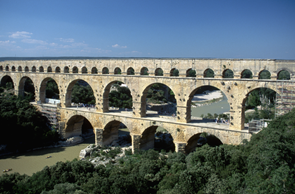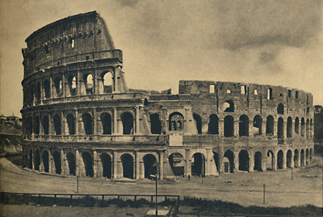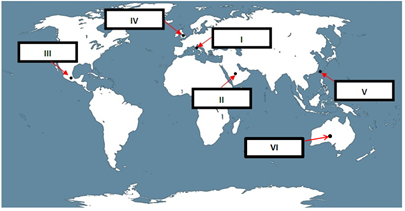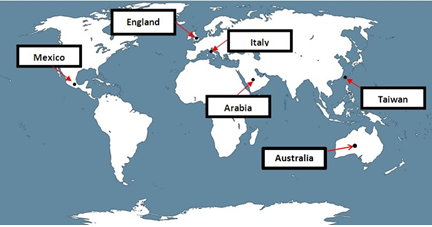

Consider the following statements regarding the distinctive characteristics of hominids.
1. They had a large brain size.
2. They had an upright posture.
3. They were quadrupeds with flexible forelimbs.
4. They had specialized hand-form, to make tools.
Which of the above are correct statements regarding the features of hominids?
a). 1 and 3
b). 2 and 3
c). 3 and 4
d). 1, 2 and 4
d). 1, 2 and 4
Name any two fossils that have been found in Europe.
The earliest fossils from Europe are of Homo heidelbergensis and Homo neanderthalensis.
Why ‘The Warka Head’ is considered a world-famous piece of sculpture?
It is dated back to 3000 BC. It is admired for delicate modelling of the woman’s mouth, chin, and cheeks. It was modelled in a hard stone that would have been imported from a distance.
What are Steles?
Steles, or cylindrical seals, are a typical Sumerian invention. These seals were used from the 3rd millennium BC, in Mesopotamia, for authenticating the cuneiform documents. The cylinder seals were rolled over wet clay to mark or identify clay tablets, envelopes, ceramics, and bricks.
Choose the correct option:
Crusade were fought to claim Jerusalem, outcome of the crusades was/were
A. The first crusade was fought during 1099-1109.
B. During the first crusade, soldiers from Germany and England captured Antioch in Syria.
C. During the second crusade, soldiers from Germany and France tried to capture Damascus
D. Their victory was accompanied without the slaughtering of Jews.
C. During the second crusade, soldiers from Germany and France tried to capture Damascus.
From among the following, which one depicts the correct meaning of the term quriltais, concerning assembly in Mongolian kingdom?
A: Assembly of chieftains
B: Assembly of people
C: Assembly of horsemen
D: Assembly of soldiers
A: Assembly of chieftains
Choose the correct option:
What was the name of the wazir who drafted the speech that Ghazan Khan gave to his Mongol compatriots?
A: Malik Faridullah Khan
B: Rashiduddin
C: Shaheed
D: Sulaiman
B: Rashiduddin
Name the first king of the Franks tribe who later ruled France.
Clovis
Which of the following Christian humanists had written the book Utopia?
A: Erasmus
B: Martin Luther
C: Thomas More
D: Johannes Kepler
C: Thomas More
Find out, from the following pairs, which one is correctly matched:
A. The Last Supper: Michelangelo
B. Petrarch: Padua University
C. The Sistine Chapel ceiling: Brunelleschi
D. The Duomo: Poet Laureate
B: Petrarch: Padua University
Mention one reason why the Portuguese colonised Brazil.
Brazil had no known gold or silver mines, even then Portuguese colonised it because of the availability of brazilwood trees in huge numbers. The timber of the tree produces a beautiful red dye.
Give the meaning of the term ‘Night of Tears’.
There was a fight between the Aztecs and the Spaniards. In the fight, 600 conquistadores and many more of their Tlaxcalan allies were killed. It is known as the ‘Night of Tears’.
Cite one reason why did the railway transport become an alternative to the canal transport.
The canal transport posed many problems, like congestion of vessels in canals, slow movement, frost, flood or drought prolonged the time for transportation. At this juncture, railways appeared as a convenient alternative to canal transport.
Consider the following inventions. Arrange chronologically with their year of invention, starting from the earliest:
1. The flying shuttle loom
2. The spinning jenny
3. The water frame
4. The mule
The correct sequence is:
a). 1, 2, 3, 4
b). 1, 3, 2, 4
c). 4, 3, 2, 1
d). 2, 3, 4, 1
a). 1, 2, 3, 4
Indicate which of the following options is NOT correct.
The French philosopher Jean-Jacques Rousseau admired the natives because:
A: They were politically inactive.
B: They did not get affected by the corruption of ‘civilisation’.
C: They were good at trading activities.
D: They helped European traders.
C: They were good at trading activities.
Indicate which of the following options is NOT correct.
During the eighteenth century, areas of America and Australia were occupied by immigrants from Europe.
A. The name ‘Canada’ is derived from the word 'Kanata'.
B. America got its name from Amerigo Vespucci, an explorer.
C. The French philosopher Jean-Jacques Rousseau disliked the natives.
D. The European settlers adopted the practice of smoking tobacco.
C. The French philosopher Jean-Jacques Rousseau disliked the natives.
Consider the following statements regarding the June Democracy Movement, which led to the revision of the Yusin Constitution:
I. Increased levels of education and media advancements
II. Suppression of Gwangju Democratisation Movement
III. The alliance between students and middle classes against government
IV. The revelation of the government’s attempt to minimize inquiries of a university student’s death
Which of the following statement(s) is/are correct?
a). Only I
b). I and II
c). II and III
d). III and IV
d: III and IV
Assertion (A): Guomindang failed to unite the country of China.
Reason (R): Guomindang had a narrow social base and limited political vision.
a. Both A and R are true and R is the correct explanation of A.
b. Both A and R are true but R is not the correct explanation of A.
c. A is true but R is false.
d. A is false but R is true.
a. Both A and R are true and R is the correct explanation of A.
Identify the following image and write its name.

The image represents Pont du Gard, near Nimes, France, first century BCE. Roman engineers built massive aqueducts, over three continents, to carry water.
Identify the following image and write its name.

The image represents the Colosseum, built in 79 CE, where gladiators fought wild beasts. It could accommodate 60,000 people.
State any three elements that historians/archeologists consider, while analyzing the emergence of the spoken language.
There are various views on the emergence of spoken language:
1. It is assumed that the brain of Homo habilis had certain features, which would have made it possible for them to speak.
2. It is assumed that language started developing two million years ago. However, the evolution of the vocal tract was equally important. The vocal tract evolved around 200000 years ago, specifically associated with modern humans.
3. It is suggested that language and art developed around the same time, which is 40,000 to 35,000 years ago. The development of spoken language has been seen as closely connected with art, as both are modes of communication.
What were the pillars of the Roman Empire?
The pillars of the Roman Empire were as follows:
a). Emperor, who was known as Principate, was the sole ruler and the only real source of authority.
b). Senate, which had existed for centuries, represented the wealthy families of Rome, and later those of Italian descent, mostly landowners.
c). Army of the Roman Empire was a paid and professional army. The army was the single largest organized body of the Roman Empire. It had the power to decide the fate of the emperors.
What was the status of women in the Roman Empire?
The women in the Roman Empire enjoyed considerable legal rights in owning and managing property. They were married off in their late teens or early twenties. Arranged marriage was the general norm and there is no doubt that women were often subject to domination by their husbands. The typical form of marriage was where the wife was not transferred to her husband’s authority, but retained her full rights in her natal family. While the dowry went to the husband for the duration of the marriage, the women remained a primary heir to her father and became an independent property owner on her father’s death. Under law, a married couple was not one financial entity but two, and the wife enjoyed complete legal independence. Divorce was easy to get. Either husband or wife could give a notice of intent to dissolve their marriage.
Fourteen century was the age of social unrest. How?
The income of lords was declining rapidly, because of the fall in prices of agriculture products and the rise in wages of labourers. In extreme anxiety, they tried to quit the money contracts and revive labour services. That was fiercely opposed by all peasants, including better-educated and more prosperous ones. The peasants revolted in Flanders in 1323, in France in 1358 and in England in 1381. Although the revolts were ruthlessly crushed, one significant thing was that they surfaced with more brutal intensity in the areas, which had experienced economic growth. It was a sign of peasants' attempt for securing their gains, which they had made in previous centuries. The aggression of peasants made it certain that the old feudal order would not be reinstalled. Thus, the lords were able to crush the rebellions but were not able to reinstitute old feudal privileges.
How did London emerge as a significant centre for global trade during the Industrial Revolution and how rivers and coastline facilitated transport in England?
During the eighteenth century, London was the largest city in England and was the hub of markets as well.
London was a significant city for global trade. By the 18th century, global trade shifted from Mediterranean ports of Italy and France to the Atlantic ports of Holland and Britain. London became the place for international trade, by replacing Amsterdam. London also became a centre of a triangular trade between England, Africa, and the West Indies.
Development of transport system: Rivers and coastline facilitated the movement of goods in England. Transport by waterways was cheaper and faster than land, until the introduction of the railways. During 1724, rivers in England provided 1,160 miles of navigable water. Rivers provided easy movement of coastal ships (coasters) since all rivers flow into the sea.
What was the role of temple in the Mesopotamian society?
From 5000 BCE, settlements had begun to develop in southern Mesopotamia. The earliest cities emerged from some of these settlements. These were of two kinds: those that gradually developed around temples; those that developed as centres of trade; and imperial cities.
In Mesopotamia, each town and city was believed to be protected by its own, unique deity or God. The temple was the nucleus of the cities, often playing many religious roles, socio-economic roles, etc. as many cities developed around temples.
The Mesopotamians, however, did not have access to sufficiently durable mineral resources and were forced to build temples with mud-brick. Naturally, they did not hold up very long and were constantly being rebuilt or repaired. The earliest known temple was a small shrine made of unbaked bricks. Later on, these temples became large, with several rooms around an open courtyard and were constructed in brick.
Temples were the residences of various Gods: of the Moon God of Ur, or of Inanna the Goddess of Love and War. Constructed in brick, temples became larger over time, with several rooms around open courtyards. Some of the early ones were possibly not unlike the ordinary house – for the temple was the house of a God. But temples always had their outer walls going in and out at regular intervals, which no ordinary building ever had.
The god was the focus of their worship. Everyone was expected to sing hymns, say prayers, make sacrifices and bring offerings of grain, curd, and fish to the local temple for the Gods. The temple was not only the place for religious activity but served administrative, educational and many other functions as well.
Although the main purpose of a Mesopotamian temple was to provide appropriate residence and luxury for the patron God, the temple had other community functions. For example, it was a storehouse for surplus produce that would sustain the city in harder times. At times, the processing of produce, for example, oil pressing, grain grinding, spinning and the weaving of woollen cloth was also done in the temple. The temple also regulated standards, such as measurements and interest rates, kept written records of distributions and allotments of grain. It provided education and training for those people who required literacy. The great temples played a vital role in the lives of the Mesopotamians and became the main urban institution.
City life, trade, and writing were connected in Mesopotamia. Explain.
The earliest form of writing dates back to 3200 BCE. Originally, Sumerian writing was pictographic, that is, scribes drew pictures of representations of objects. People back then drew ‘word-pictures’ on wet clay tablets, using a pointed instrument, called a stylus.
Writing began when the Mesopotamian society needed to keep records of transactions – because in city life, transactions occurred at different times, and involved many people and a variety of goods. The first Mesopotamian tablets, written around 3200 BCE, recorded transactions of goods that were brought into or distributed from the temples of Uruk. These tablets were mostly found in temples and some private houses associated with seals and sealing signified that it was mostly related to storage and trade. The most common cuneiform tablets record signs of oil, beer, perfume, sheep, clothing, oxen, fish, and bread loaves, etc. suggesting storage and transaction records.
In city life, transactions occurred at different times, involving many people and a variety of goods. So, writing developed out of recordkeeping and contracts for storage, transportation and exchange of goods and continued to be used mostly for that.
Another large category of cuneiform writing was used not only for keeping records, but also for making dictionaries, giving legal validity to land transfers, narrating the deeds of kings and announcing the changes, a king had made in the customary laws of the land. These tablets with accounts and administrative records were mostly found in archive rooms. Initially, archives were only in temples. Later, as palaces arose, they too had archives that kept these tablets.
By 2600 BCE or so, the letters became cuneiform, and the language was Sumerian. Writing was now used not only for keeping records, but also for making dictionaries, giving legal validity to land transfers, narrating the deeds of kings, and announcing the changes a king had made in the customary laws of the land.
Sumerian, the earliest known language of Mesopotamia, was gradually replaced, after 2400 BCE, by the Akkadian language. Cuneiform writing in the Akkadian language continued in use until the first century CE, that is, for more than 2,000 years.
The sound of a cuneiform sign was not a single consonant or vowel, but syllables. Thus, the signs that a Mesopotamian scribe had to learn ran into hundreds, and he had to be able to handle a wet tablet and get it written before it dried. So, writing was a skilled craft but, more important, it was an enormous intellectual achievement, conveying, in visual form, the system of sounds of a particular language.
Describe the layout of a city in the Islamic World.
Medieval Islamic civilisation flourished due to the increase in the number of cities. Many of these new cities were found with the intention to settle the Arab soldiers (jund), who formed the backbone of the local administration in the Islamic World.
Among this class of garrison cities, which were called misr (the Arabic name for Egypt), were Kufa and Basra in Iraq, as well as Fustat and Cairo in Egypt. Within half a century of its establishment as the capital of the Abbasid Caliphate (800 CE), the population of Baghdad had reached around 1 million people.
Alongside these cities were older towns, such as Damascus, Isfahan and Samarqand; all of which received a new lease of life. Their size and population surged, which was supported by an expansion in the production of foodgrains and raw materials, such as cotton and sugar, for urban manufactures. Simultaneously, a vast urban network developed, which linked one town with another and ultimately formed a circuit.
At the heart of a medieval Islamic city were two buildings: the congregational mosque (masjid al-jami), which could be seen from a distance, and the central market place (suq), which contained shops in a row, merchants lodgings (fanduq) and the offices of the money changers. Both of these buildings exhibited the cultural and economic power of the Muslim Empire.
The central presence of mosque, a religious building, is a testimony to the primary role that was held by religion within the medieval Islamic city, particularly in the public life of the people.
The medieval Islamic cities were also homes to administrators (ayan - eyes of the state), and scholars and merchants (tujjar), who lived close to the centre.
Ordinary citizens and soldiers had their living quarters in the city’s outer circle, each of which was fitted with its own mosque, church or synagogue (Jewish temple), a subsidiary market and public bath (hammam), an important meeting place.
At the outskirts of the city were houses for the urban poor, a market that sold green vegetables and fruits that were brought from the countryside, caravan stations and 'unclean' shops - those which dealt with activities like tanning and butchering.
Houses, which were planned according to their location and inhabitants, contained huts, apartments or large buildings that were made of stone or brick, lining alleys.
Beyond the city walls were inns for people to rest after the closure of the city gates, which were opened in the morning, and cemeteries. However, there were variations on this typology, as this depended on the nature of the landscape, political traditions and historical events.
Describe the condition of women in changing Europe.
Though new ideas and views, like individuality and citizenship, regarding human beings were making their way, they couldn’t affect the lives of women.
Families were patriarchal; men from upper class families led the public life and were the decision-makers of their families. The sons were provided with education to lead family businesses in future or public life.
Women had no say in business matters, though their dowries were invested in family businesses; marriages were a means to support business alliances and profits.
Those girls whose dowry was not arranged properly were sent to convents to lead the life of nuns. Women were looked upon as keepers of households only; the public role of women was limited.
The condition of women in families of merchant was in contrast to that of aristocratic families. The wives of shopkeepers backed their husbands in daily business, whereas the wives of merchants and bankers looked after their businesses when they were away. The early death of a merchant forced his widow to play a bigger public role than those in aristocratic families.
Several women were intellectual humanists; Venetian Cassandra Fedele was one of them. She was known for her expertise in Greek and Latin languages and was invited to deliver lectures at the University of Padua. Her works conveyed the common view for education. She wrote: ‘Even though the study of letters promises and offers no reward for women and no dignity, every woman ought to seek and embrace these studies.’
Fedele was among those women who condemned the republic for creating a highly limited description of the freedom that gives preferential treatment, i.e. the wishes of men over those of women. She was known for her proficiency in Greek and Latin, and was invited to give orations at the University of Padua.
Another outstanding woman was the Marchesa of Mantua, Isabella d’Este, who ruled the state in the absence of her husband and the court of that small state got fame for its intellectual vividness.
The writings of women of that period disclosed their confidence that they should have economic power, property and education to get individuality in a world dominated by men.
What developments in the field of science and philosophy took place in the age of Renaissance? Highlight the contributions made by the Arabs.
The monks and clergymen were familiar with the works of Greek and Roman scholars from the ‘Middle Ages’ but they did not popularize those writings for the other classes of people; they kept this knowledge as their exclusive intellectual treasure. By the fourteenth century, various scholars started to read the translations of Greek philosophers, like Plato and Aristotle, in Arabic; for this they were indebted not to their own scholars, but to Arab translators who had carefully preserved and translated ancient manuscripts (Plato was Aflatun, and Aristotle Aristu in Arabic).
This led to a chain of spreading of knowledge. Several Europeans read Greek works in Arabic, and the Greeks translated Arabic and Persian scholars work into European languages. Those works were related to natural science, mathematics, astronomy, medicine and chemistry. The Almagest of Ptolemy was the work of 140 BC on astronomy, in Greek language, and was translated into Arabic; it had carried an Arabic alphabet ‘al’ which shows connection with Arabs.
Among the Muslim writers who were regarded as men of wisdom in the Italian world were Ibn Sina (‘Avicenna’ in Latin, 980- 1037), an Arab physician and philosopher of Bukhara in Central Asia, and al-Razi (‘Rhazes’), author of a medical encyclopaedia. Ibn Rushd (‘Averroes’ in Latin, 1126-98), an Arab philosopher of Spain, tried to resolve the tension between philosophical knowledge (faylasuf) and religious beliefs. The Christian thinkers assumed the method of Arab philosopher of Spain who tried to resolve the tension between philosophical knowledge and religious faiths.
Humanists reached out to people in a variety of ways. Though the curricula in universities were predominantly on law, medicine and theology, humanist subjects were gradually introduced in schools in Italy, as well as in other European countries. A Belgian and a professor of medicine, Andreas Vesalius, at the University of Padua first dissected the human body, which was the beginning of modern physiology.
The humanists were making ways in life of people through several methods. The program of study in universities continued to be dominated by law, medicine and theology, humanist subjects were gradually introduced in schools, in all European countries, including Italy. Even science subjects, like physics, anatomy and geometry helped in inserting realism in art and changes in architecture. Formal and institutionalised university education was not the only way through which humanists shaped the minds of their age. Art, architecture and books were also wonderfully effective in spreading humanist ideas among the common people.
The Capture of Bukhara
Juwaini, a late-thirteenth-century Persian chronicler of the Mongol rulers of Iran, carried an account of the capture of Bukhara in 1220. After the conquest of the city, Juwaini reported, Genghis Khan went to the festival ground where the rich residents of the city were and addressed them: ‘O’ people know that you have committed great sins, and that the great ones among you have committed these sins. If you ask me what proof I have for these words, I say it is because I am the punishment of God. If you had not committed great sins, God would not have sent a punishment like me upon you’… Now one man had escaped from Bukhara after its capture and had come to Khurasan. He was questioned about the fate of the city and replied: ‘They came, they [mined the walls], they burnt, they slew, they plundered and they departed.’
a) Who was Juwaini?
b) What was the reason given by Genghis Khan, to the residents of Bukhara, after its capture by the Mongols?
c) Describe the account given by the survivor about the fate of Bukhara during the Mongol onslaught. (2+2+2=6 marks)
a) Juwaini was a Persian chronicler of the Mongol rulers of Iran, during the late thirteenth century.
b) After capturing Bukhara, Genghis Khan, addressing the city residents, claimed that God had sent him, as a punishment, for the sins committed by the city’s residents.
c) According to the survivor who escaped to Khurasan, the Mongols, upon their arrival, destroyed the walls by mining, after which they slaughtered the city’s residents. They then plundered the city’s wealth before finally departing.
Dona Marina
Bernard Diaz del Castillo (1495-1584) wrote in his True History of the Conquest of Mexico that the people of Tabasco gave Cortes a woman attendant called Dona Marina. She was fluent in three local languages and was able to play a crucial role as interpreter for Cortes. ‘This was the great beginning of our conquests, and without Dona Marina, we could not have understood the language of New Spain and Mexico.’ Diaz thought she was a princess, but the Mexicans called her ‘Malinche’, a word meaning ‘betrayal’. Malinchista means someone who slavishly copies the costumes and language of other people.
a). Name the author and the book from where this passage has been extracted.
b). Who attributed the conquest of Mexico to Dona Marina?
c). How was Dona Marina viewed by the author and by the Mexicans? (2+2+2=6 marks)
a) The above passage has been extracted from the book ‘True History of the Conquest of Mexico’, which was written by Bernard Diaz Del Castillo (1495-1584).
b) Hernan Cortes, who had conquered New Spain and Mexico, attributed his successes to the crucial role played by Dona Marina.
c) While Bernard Diaz believed Dona Marina to be a princess, the Mexicans saw her as a traitor, calling her ‘Malinche’, which means ‘betrayal’.
The Examination System
Entry to the elite ruling class (about 1.1 million till 1850) had been largely through an examination. This required writing an eight-legged essay [pa-ku wen] in classical Chinese in a prescribed form. The examination was held twice every three years, at different levels and of those allowed to sit only 1-2 percent passed the first level, usually by the age of 24, to become what was called ‘beautiful talent’. At any given time before 1850, there were about 526,869 civil and 212,330 military provincial (sheng yuan) degree holders in the whole country. Since there were only 27,000 official positions, many lower-level degree holders did not have jobs. The examination acted as a barrier to the development of science and technology as it demanded only literary skills. In 1905, it was abolished as it was based on skills in classical Chinese learning that had, it was felt, no relevance for the modern world.
a). What was the relevance of the examination system in pre-modern China?
b). How did the examination system hinder scientific development?
c). When and why was the examination system abolished? (2+2+2=6 marks)
a). The examination system, in pre-modern China, determined entry to the elite ruling class.
b). The examination system in China was a barrier to scientific and technological development, as it demanded only literary skills in classical Chinese learning.
c). The examination system was abolished in 1905. This was done since it was based on skills in classical Chinese learning which, many felt, was irrelevant in the modern world.
On the given world map, identify the marked places:



Take your CBSE board preparation to another level with AI based and rich media animation on Extramarks - The Learning App.
Features of Learning App